Analysis of Winter Coat Shedding in Relation to Animal State: Report
VerifiedAdded on 2022/11/27
|8
|1712
|219
Report
AI Summary
This report presents a statistical analysis of the relationship between the fraction of winter coat shed in summer and the animal state, focusing on mountain goats. The study employed frequencies, descriptive statistics (means, standard deviations), independent sample t-tests, and general linear models (logistic regression) to analyze the data. The results revealed that the majority of the goats were female and not looking after kids. Descriptive statistics provided insights into the fraction of pixels representing shed and unshed regions. T-tests indicated differences in shedding between males and females. General linear models showed that animal gender was not responsible for change in fraction during winter. The analysis concludes that changes in the fraction of winter coat shed in summer are associated with animal state.
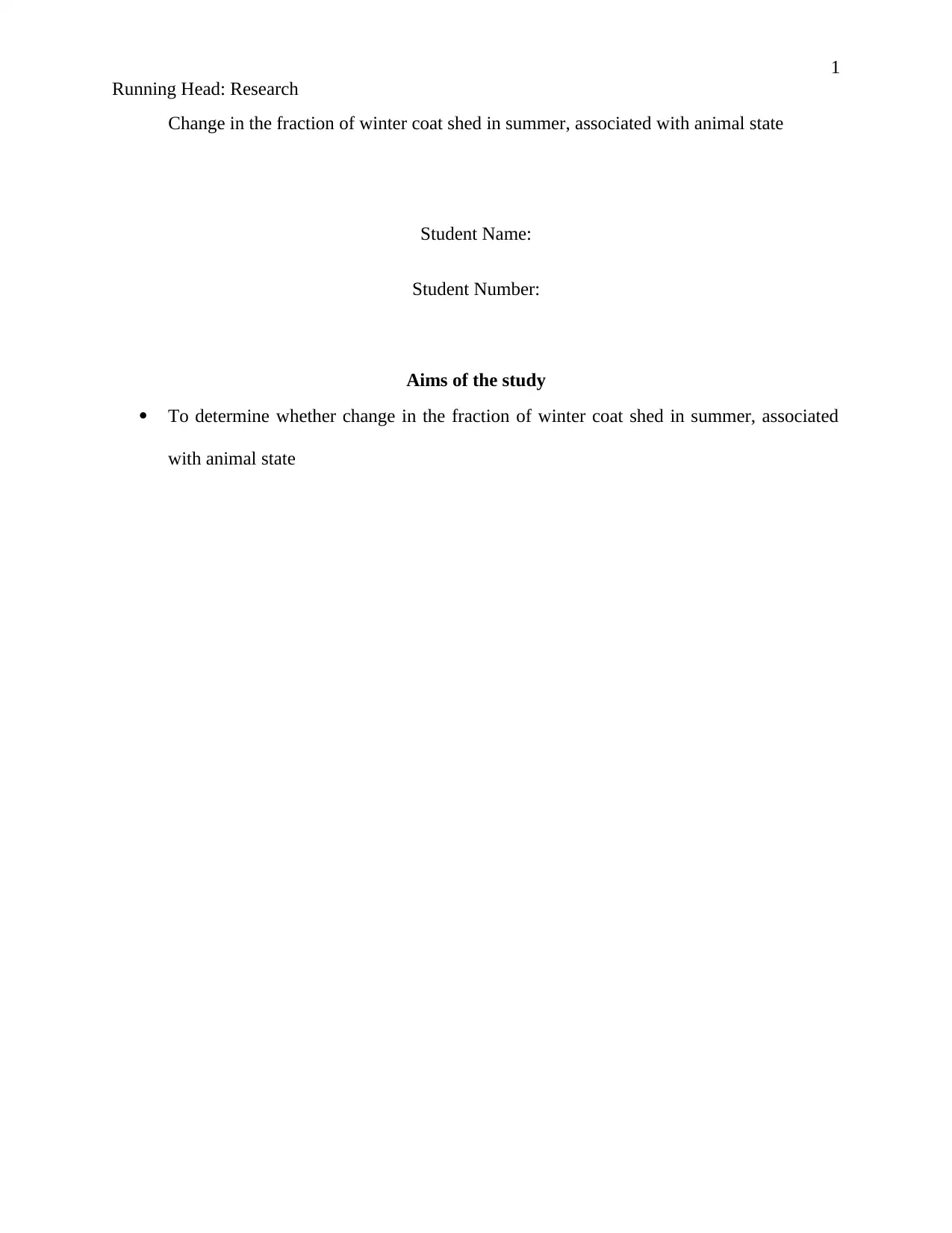
1
Running Head: Research
Change in the fraction of winter coat shed in summer, associated with animal state
Student Name:
Student Number:
Aims of the study
To determine whether change in the fraction of winter coat shed in summer, associated
with animal state
Running Head: Research
Change in the fraction of winter coat shed in summer, associated with animal state
Student Name:
Student Number:
Aims of the study
To determine whether change in the fraction of winter coat shed in summer, associated
with animal state
Paraphrase This Document
Need a fresh take? Get an instant paraphrase of this document with our AI Paraphraser
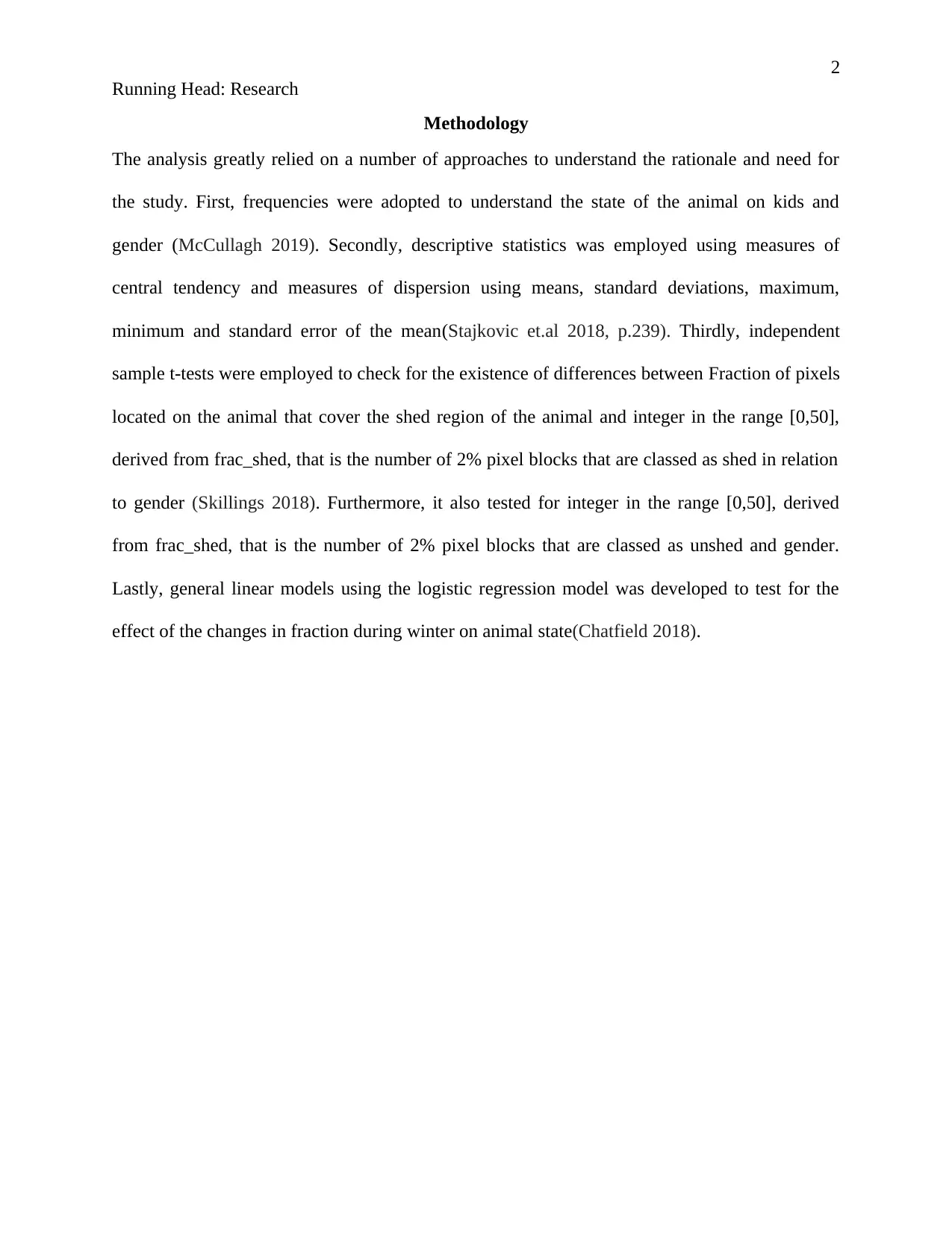
2
Running Head: Research
Methodology
The analysis greatly relied on a number of approaches to understand the rationale and need for
the study. First, frequencies were adopted to understand the state of the animal on kids and
gender (McCullagh 2019). Secondly, descriptive statistics was employed using measures of
central tendency and measures of dispersion using means, standard deviations, maximum,
minimum and standard error of the mean(Stajkovic et.al 2018, p.239). Thirdly, independent
sample t-tests were employed to check for the existence of differences between Fraction of pixels
located on the animal that cover the shed region of the animal and integer in the range [0,50],
derived from frac_shed, that is the number of 2% pixel blocks that are classed as shed in relation
to gender (Skillings 2018). Furthermore, it also tested for integer in the range [0,50], derived
from frac_shed, that is the number of 2% pixel blocks that are classed as unshed and gender.
Lastly, general linear models using the logistic regression model was developed to test for the
effect of the changes in fraction during winter on animal state(Chatfield 2018).
Running Head: Research
Methodology
The analysis greatly relied on a number of approaches to understand the rationale and need for
the study. First, frequencies were adopted to understand the state of the animal on kids and
gender (McCullagh 2019). Secondly, descriptive statistics was employed using measures of
central tendency and measures of dispersion using means, standard deviations, maximum,
minimum and standard error of the mean(Stajkovic et.al 2018, p.239). Thirdly, independent
sample t-tests were employed to check for the existence of differences between Fraction of pixels
located on the animal that cover the shed region of the animal and integer in the range [0,50],
derived from frac_shed, that is the number of 2% pixel blocks that are classed as shed in relation
to gender (Skillings 2018). Furthermore, it also tested for integer in the range [0,50], derived
from frac_shed, that is the number of 2% pixel blocks that are classed as unshed and gender.
Lastly, general linear models using the logistic regression model was developed to test for the
effect of the changes in fraction during winter on animal state(Chatfield 2018).
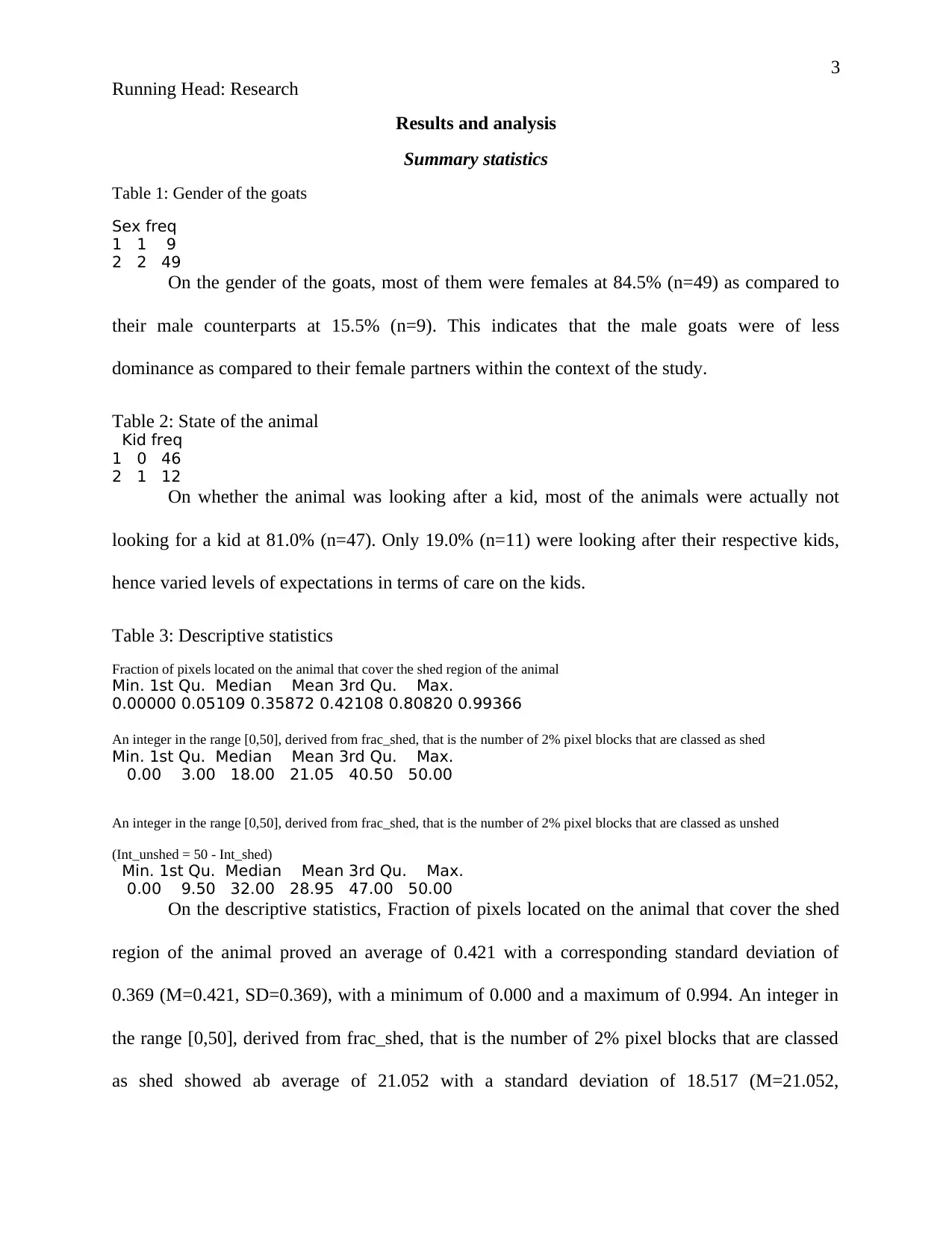
3
Running Head: Research
Results and analysis
Summary statistics
Table 1: Gender of the goats
Sex freq
1 1 9
2 2 49
On the gender of the goats, most of them were females at 84.5% (n=49) as compared to
their male counterparts at 15.5% (n=9). This indicates that the male goats were of less
dominance as compared to their female partners within the context of the study.
Table 2: State of the animal
Kid freq
1 0 46
2 1 12
On whether the animal was looking after a kid, most of the animals were actually not
looking for a kid at 81.0% (n=47). Only 19.0% (n=11) were looking after their respective kids,
hence varied levels of expectations in terms of care on the kids.
Table 3: Descriptive statistics
Fraction of pixels located on the animal that cover the shed region of the animal
Min. 1st Qu. Median Mean 3rd Qu. Max.
0.00000 0.05109 0.35872 0.42108 0.80820 0.99366
An integer in the range [0,50], derived from frac_shed, that is the number of 2% pixel blocks that are classed as shed
Min. 1st Qu. Median Mean 3rd Qu. Max.
0.00 3.00 18.00 21.05 40.50 50.00
An integer in the range [0,50], derived from frac_shed, that is the number of 2% pixel blocks that are classed as unshed
(Int_unshed = 50 - Int_shed)
Min. 1st Qu. Median Mean 3rd Qu. Max.
0.00 9.50 32.00 28.95 47.00 50.00
On the descriptive statistics, Fraction of pixels located on the animal that cover the shed
region of the animal proved an average of 0.421 with a corresponding standard deviation of
0.369 (M=0.421, SD=0.369), with a minimum of 0.000 and a maximum of 0.994. An integer in
the range [0,50], derived from frac_shed, that is the number of 2% pixel blocks that are classed
as shed showed ab average of 21.052 with a standard deviation of 18.517 (M=21.052,
Running Head: Research
Results and analysis
Summary statistics
Table 1: Gender of the goats
Sex freq
1 1 9
2 2 49
On the gender of the goats, most of them were females at 84.5% (n=49) as compared to
their male counterparts at 15.5% (n=9). This indicates that the male goats were of less
dominance as compared to their female partners within the context of the study.
Table 2: State of the animal
Kid freq
1 0 46
2 1 12
On whether the animal was looking after a kid, most of the animals were actually not
looking for a kid at 81.0% (n=47). Only 19.0% (n=11) were looking after their respective kids,
hence varied levels of expectations in terms of care on the kids.
Table 3: Descriptive statistics
Fraction of pixels located on the animal that cover the shed region of the animal
Min. 1st Qu. Median Mean 3rd Qu. Max.
0.00000 0.05109 0.35872 0.42108 0.80820 0.99366
An integer in the range [0,50], derived from frac_shed, that is the number of 2% pixel blocks that are classed as shed
Min. 1st Qu. Median Mean 3rd Qu. Max.
0.00 3.00 18.00 21.05 40.50 50.00
An integer in the range [0,50], derived from frac_shed, that is the number of 2% pixel blocks that are classed as unshed
(Int_unshed = 50 - Int_shed)
Min. 1st Qu. Median Mean 3rd Qu. Max.
0.00 9.50 32.00 28.95 47.00 50.00
On the descriptive statistics, Fraction of pixels located on the animal that cover the shed
region of the animal proved an average of 0.421 with a corresponding standard deviation of
0.369 (M=0.421, SD=0.369), with a minimum of 0.000 and a maximum of 0.994. An integer in
the range [0,50], derived from frac_shed, that is the number of 2% pixel blocks that are classed
as shed showed ab average of 21.052 with a standard deviation of 18.517 (M=21.052,
⊘ This is a preview!⊘
Do you want full access?
Subscribe today to unlock all pages.

Trusted by 1+ million students worldwide
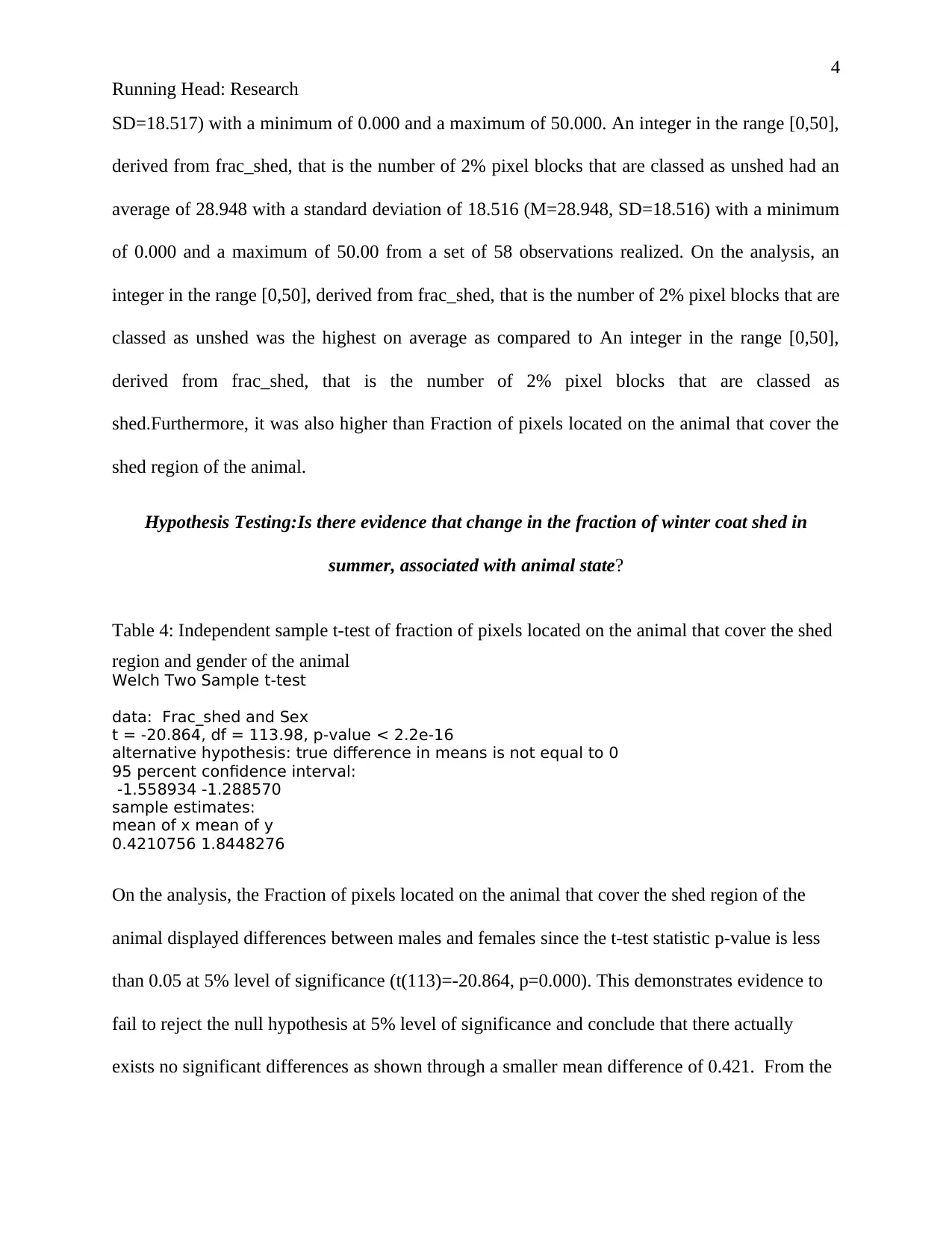
4
Running Head: Research
SD=18.517) with a minimum of 0.000 and a maximum of 50.000. An integer in the range [0,50],
derived from frac_shed, that is the number of 2% pixel blocks that are classed as unshed had an
average of 28.948 with a standard deviation of 18.516 (M=28.948, SD=18.516) with a minimum
of 0.000 and a maximum of 50.00 from a set of 58 observations realized. On the analysis, an
integer in the range [0,50], derived from frac_shed, that is the number of 2% pixel blocks that are
classed as unshed was the highest on average as compared to An integer in the range [0,50],
derived from frac_shed, that is the number of 2% pixel blocks that are classed as
shed.Furthermore, it was also higher than Fraction of pixels located on the animal that cover the
shed region of the animal.
Hypothesis Testing:Is there evidence that change in the fraction of winter coat shed in
summer, associated with animal state?
Table 4: Independent sample t-test of fraction of pixels located on the animal that cover the shed
region and gender of the animal
Welch Two Sample t-test
data: Frac_shed and Sex
t = -20.864, df = 113.98, p-value < 2.2e-16
alternative hypothesis: true difference in means is not equal to 0
95 percent confidence interval:
-1.558934 -1.288570
sample estimates:
mean of x mean of y
0.4210756 1.8448276
On the analysis, the Fraction of pixels located on the animal that cover the shed region of the
animal displayed differences between males and females since the t-test statistic p-value is less
than 0.05 at 5% level of significance (t(113)=-20.864, p=0.000). This demonstrates evidence to
fail to reject the null hypothesis at 5% level of significance and conclude that there actually
exists no significant differences as shown through a smaller mean difference of 0.421. From the
Running Head: Research
SD=18.517) with a minimum of 0.000 and a maximum of 50.000. An integer in the range [0,50],
derived from frac_shed, that is the number of 2% pixel blocks that are classed as unshed had an
average of 28.948 with a standard deviation of 18.516 (M=28.948, SD=18.516) with a minimum
of 0.000 and a maximum of 50.00 from a set of 58 observations realized. On the analysis, an
integer in the range [0,50], derived from frac_shed, that is the number of 2% pixel blocks that are
classed as unshed was the highest on average as compared to An integer in the range [0,50],
derived from frac_shed, that is the number of 2% pixel blocks that are classed as
shed.Furthermore, it was also higher than Fraction of pixels located on the animal that cover the
shed region of the animal.
Hypothesis Testing:Is there evidence that change in the fraction of winter coat shed in
summer, associated with animal state?
Table 4: Independent sample t-test of fraction of pixels located on the animal that cover the shed
region and gender of the animal
Welch Two Sample t-test
data: Frac_shed and Sex
t = -20.864, df = 113.98, p-value < 2.2e-16
alternative hypothesis: true difference in means is not equal to 0
95 percent confidence interval:
-1.558934 -1.288570
sample estimates:
mean of x mean of y
0.4210756 1.8448276
On the analysis, the Fraction of pixels located on the animal that cover the shed region of the
animal displayed differences between males and females since the t-test statistic p-value is less
than 0.05 at 5% level of significance (t(113)=-20.864, p=0.000). This demonstrates evidence to
fail to reject the null hypothesis at 5% level of significance and conclude that there actually
exists no significant differences as shown through a smaller mean difference of 0.421. From the
Paraphrase This Document
Need a fresh take? Get an instant paraphrase of this document with our AI Paraphraser
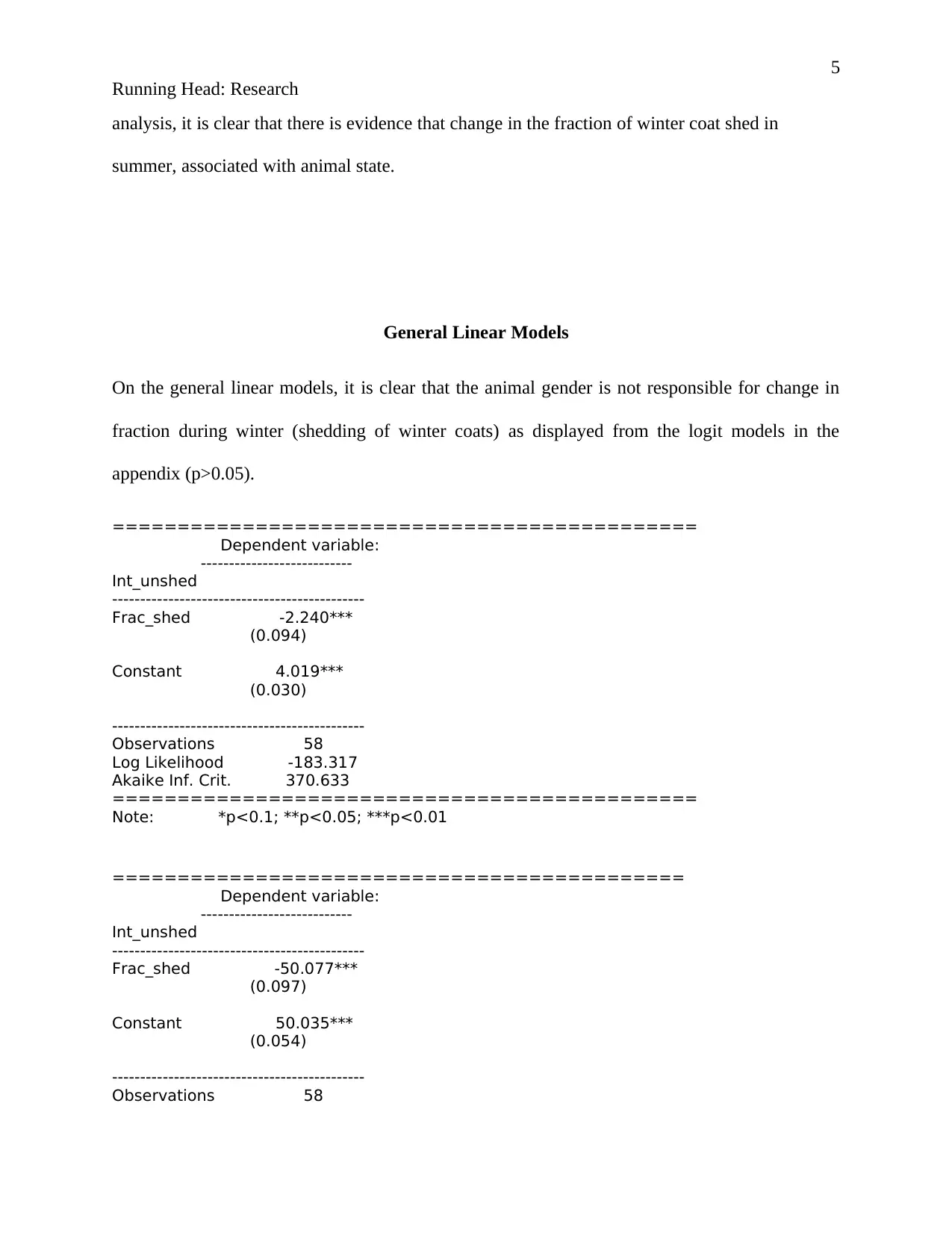
5
Running Head: Research
analysis, it is clear that there is evidence that change in the fraction of winter coat shed in
summer, associated with animal state.
General Linear Models
On the general linear models, it is clear that the animal gender is not responsible for change in
fraction during winter (shedding of winter coats) as displayed from the logit models in the
appendix (p>0.05).
=============================================
Dependent variable:
---------------------------
Int_unshed
---------------------------------------------
Frac_shed -2.240***
(0.094)
Constant 4.019***
(0.030)
---------------------------------------------
Observations 58
Log Likelihood -183.317
Akaike Inf. Crit. 370.633
=============================================
Note: *p<0.1; **p<0.05; ***p<0.01
============================================
Dependent variable:
---------------------------
Int_unshed
---------------------------------------------
Frac_shed -50.077***
(0.097)
Constant 50.035***
(0.054)
---------------------------------------------
Observations 58
Running Head: Research
analysis, it is clear that there is evidence that change in the fraction of winter coat shed in
summer, associated with animal state.
General Linear Models
On the general linear models, it is clear that the animal gender is not responsible for change in
fraction during winter (shedding of winter coats) as displayed from the logit models in the
appendix (p>0.05).
=============================================
Dependent variable:
---------------------------
Int_unshed
---------------------------------------------
Frac_shed -2.240***
(0.094)
Constant 4.019***
(0.030)
---------------------------------------------
Observations 58
Log Likelihood -183.317
Akaike Inf. Crit. 370.633
=============================================
Note: *p<0.1; **p<0.05; ***p<0.01
============================================
Dependent variable:
---------------------------
Int_unshed
---------------------------------------------
Frac_shed -50.077***
(0.097)
Constant 50.035***
(0.054)
---------------------------------------------
Observations 58
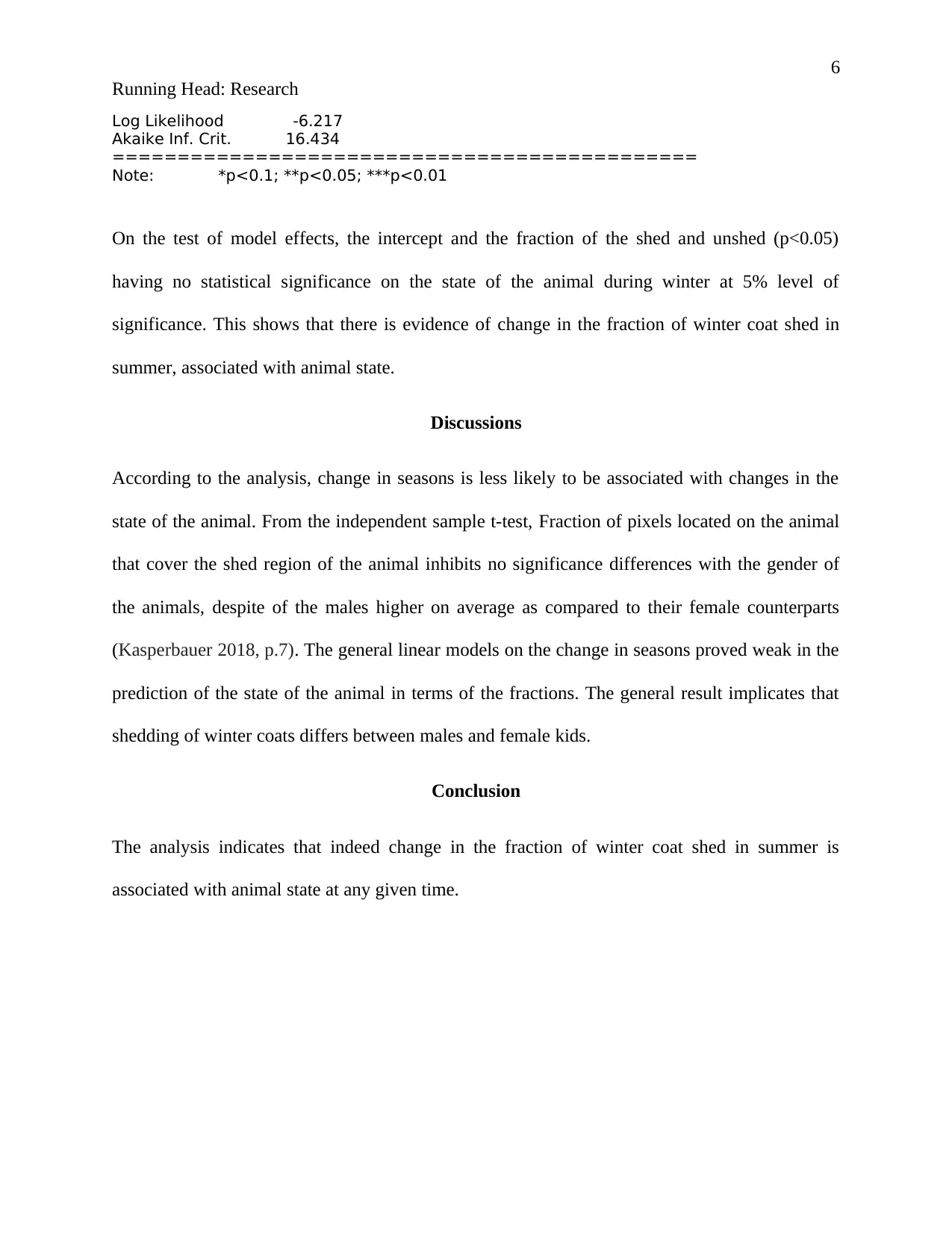
6
Running Head: Research
Log Likelihood -6.217
Akaike Inf. Crit. 16.434
=============================================
Note: *p<0.1; **p<0.05; ***p<0.01
On the test of model effects, the intercept and the fraction of the shed and unshed (p<0.05)
having no statistical significance on the state of the animal during winter at 5% level of
significance. This shows that there is evidence of change in the fraction of winter coat shed in
summer, associated with animal state.
Discussions
According to the analysis, change in seasons is less likely to be associated with changes in the
state of the animal. From the independent sample t-test, Fraction of pixels located on the animal
that cover the shed region of the animal inhibits no significance differences with the gender of
the animals, despite of the males higher on average as compared to their female counterparts
(Kasperbauer 2018, p.7). The general linear models on the change in seasons proved weak in the
prediction of the state of the animal in terms of the fractions. The general result implicates that
shedding of winter coats differs between males and female kids.
Conclusion
The analysis indicates that indeed change in the fraction of winter coat shed in summer is
associated with animal state at any given time.
Running Head: Research
Log Likelihood -6.217
Akaike Inf. Crit. 16.434
=============================================
Note: *p<0.1; **p<0.05; ***p<0.01
On the test of model effects, the intercept and the fraction of the shed and unshed (p<0.05)
having no statistical significance on the state of the animal during winter at 5% level of
significance. This shows that there is evidence of change in the fraction of winter coat shed in
summer, associated with animal state.
Discussions
According to the analysis, change in seasons is less likely to be associated with changes in the
state of the animal. From the independent sample t-test, Fraction of pixels located on the animal
that cover the shed region of the animal inhibits no significance differences with the gender of
the animals, despite of the males higher on average as compared to their female counterparts
(Kasperbauer 2018, p.7). The general linear models on the change in seasons proved weak in the
prediction of the state of the animal in terms of the fractions. The general result implicates that
shedding of winter coats differs between males and female kids.
Conclusion
The analysis indicates that indeed change in the fraction of winter coat shed in summer is
associated with animal state at any given time.
⊘ This is a preview!⊘
Do you want full access?
Subscribe today to unlock all pages.

Trusted by 1+ million students worldwide
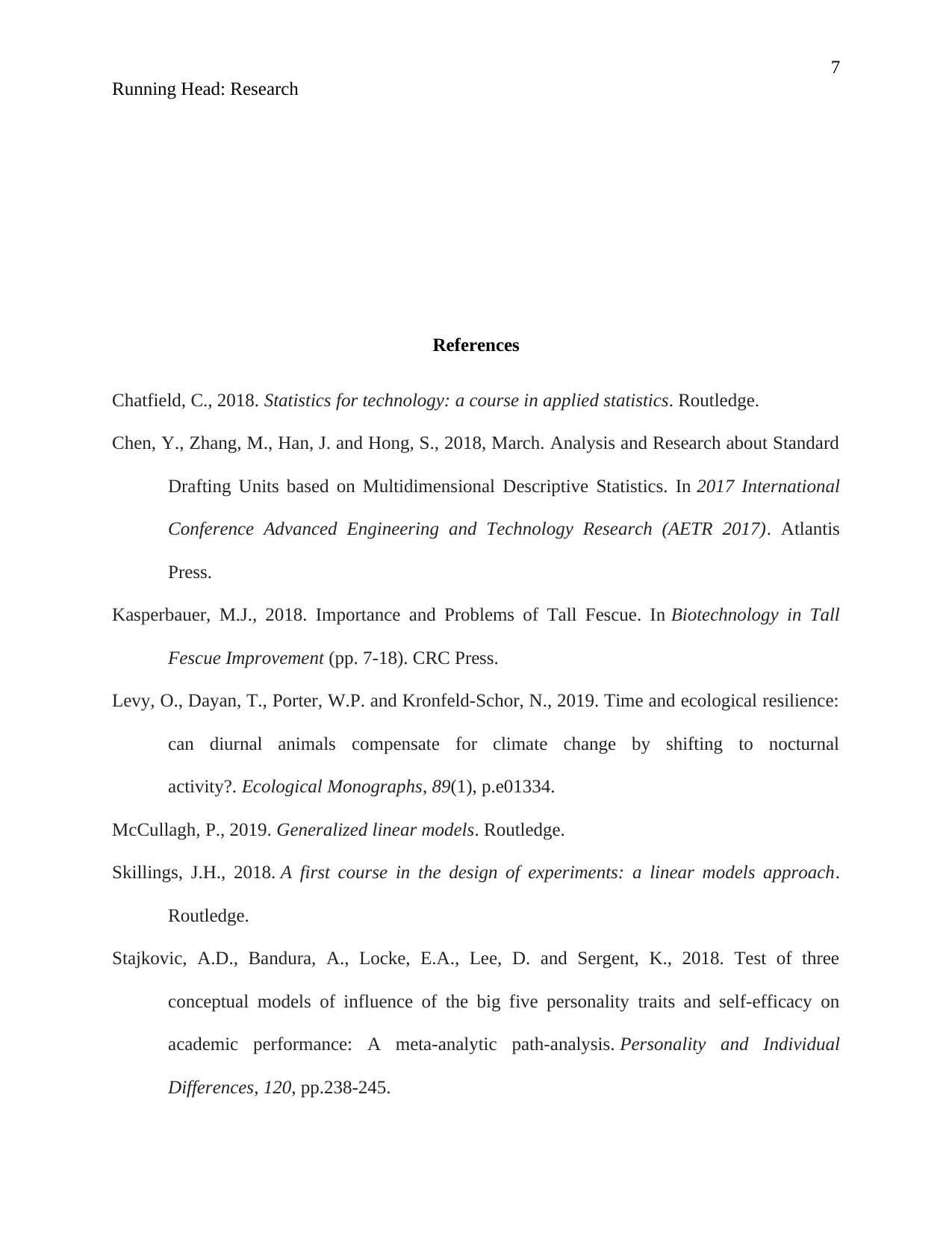
7
Running Head: Research
References
Chatfield, C., 2018. Statistics for technology: a course in applied statistics. Routledge.
Chen, Y., Zhang, M., Han, J. and Hong, S., 2018, March. Analysis and Research about Standard
Drafting Units based on Multidimensional Descriptive Statistics. In 2017 International
Conference Advanced Engineering and Technology Research (AETR 2017). Atlantis
Press.
Kasperbauer, M.J., 2018. Importance and Problems of Tall Fescue. In Biotechnology in Tall
Fescue Improvement (pp. 7-18). CRC Press.
Levy, O., Dayan, T., Porter, W.P. and Kronfeld‐Schor, N., 2019. Time and ecological resilience:
can diurnal animals compensate for climate change by shifting to nocturnal
activity?. Ecological Monographs, 89(1), p.e01334.
McCullagh, P., 2019. Generalized linear models. Routledge.
Skillings, J.H., 2018. A first course in the design of experiments: a linear models approach.
Routledge.
Stajkovic, A.D., Bandura, A., Locke, E.A., Lee, D. and Sergent, K., 2018. Test of three
conceptual models of influence of the big five personality traits and self-efficacy on
academic performance: A meta-analytic path-analysis. Personality and Individual
Differences, 120, pp.238-245.
Running Head: Research
References
Chatfield, C., 2018. Statistics for technology: a course in applied statistics. Routledge.
Chen, Y., Zhang, M., Han, J. and Hong, S., 2018, March. Analysis and Research about Standard
Drafting Units based on Multidimensional Descriptive Statistics. In 2017 International
Conference Advanced Engineering and Technology Research (AETR 2017). Atlantis
Press.
Kasperbauer, M.J., 2018. Importance and Problems of Tall Fescue. In Biotechnology in Tall
Fescue Improvement (pp. 7-18). CRC Press.
Levy, O., Dayan, T., Porter, W.P. and Kronfeld‐Schor, N., 2019. Time and ecological resilience:
can diurnal animals compensate for climate change by shifting to nocturnal
activity?. Ecological Monographs, 89(1), p.e01334.
McCullagh, P., 2019. Generalized linear models. Routledge.
Skillings, J.H., 2018. A first course in the design of experiments: a linear models approach.
Routledge.
Stajkovic, A.D., Bandura, A., Locke, E.A., Lee, D. and Sergent, K., 2018. Test of three
conceptual models of influence of the big five personality traits and self-efficacy on
academic performance: A meta-analytic path-analysis. Personality and Individual
Differences, 120, pp.238-245.
Paraphrase This Document
Need a fresh take? Get an instant paraphrase of this document with our AI Paraphraser

8
Running Head: Research
Running Head: Research
1 out of 8
Your All-in-One AI-Powered Toolkit for Academic Success.
+13062052269
info@desklib.com
Available 24*7 on WhatsApp / Email
![[object Object]](/_next/static/media/star-bottom.7253800d.svg)
Unlock your academic potential
Copyright © 2020–2025 A2Z Services. All Rights Reserved. Developed and managed by ZUCOL.